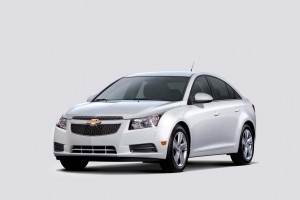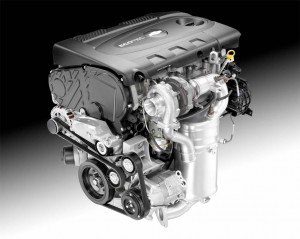There are some folks – including a few inside General Motors – who believe GM almost singlehandedly killed off the American diesel. For now, however, the question is whether it can bring the technology back to life, or more precisely, can it make the diesel part of the U.S. automotive mainstream again.
It’s certainly getting ready to try. The maker’s Chevrolet division is giving media and buyers alike a look at the new Chevy Cruze Clean Turbo Diesel – the 2.0 TD for short – at this month’s Chicago Auto Show. It’s the first time the maker has produced a diesel-powered passenger car for the U.S. market since 1986.
Back in the late 1970s and early 1980s, in the wake of the twin Mideast oil shocks, diesels were all the rage, but as fuel prices leveled off, the technology often derided as “oil burners” began to lose momentum. It didn’t help that a version GM used in its Oldsmobile line was prone to catastrophic failure.
These days, diesels are very different animals from the bad old days. Thanks to low sulfur fuel, advanced electronic controls and technologies such as turbocharging and high-pressure fuel injectors, modern diesels are clean, quick, relatively quiet and no longer prone to the sort of shake that could rattle loose a driver’s fillings.
But they’re also still remarkably durable – and deliver fuel economy that can rival a hybrid, especially on the highway where gas-electric drivetrains are least effective. The EPA rates the Chevrolet Cruze Diesel at 42 miles per gallon – and that means a range of more than 600 miles per tank.
It’s also reasonably quick, thanks to an overboost function that delivers a burst of maximum torque for up to 10 seconds. GM claims it needs 8.6 seconds to launch from 0 to 60, a respectable number, especially when compared to the current gas-powered Cruze Eco model that gets about 38 mpg. GM claims the compact diesel sedan will also out-accelerate what is likely to be its most direct rival, the Volkswagen Jetta TDI.
The two will carry a similar price tag, the Chevy coming in at $25,695 plus $810 for deliver. By comparison, the Cruze Eco is priced at $21,685 but doesn’t carry the comparable range of standard equipment as the diesel.
“Cruze turbo diesel is the cleanest operating diesel engine ever produced by General Motors, noted Gary Altman, the chief engineer for GM small cars, during a conference call.
The Cruze has already been available in Europe with a diesel – a pre-requisite considering the technology accounts for about half of all new vehicles sold on the Continent. But the U.S. version will feature a larger 2.0-liter engine that will be imported from Germany and assembled into the Cruze here in the States.
While there remain plenty of skeptics, proponents hail GM’s entry into the diesel market as offering just the boost the technology needs.
The introduction of the Chevy Cruze Diesel “is huge,” according to Allen Schaeffer, head of the Washington, D.C.-based Diesel Technology Forum. “It breaks new ground for clean diesel by having one of the domestic manufacturers introducing a passenger car diesel.”
GM isn’t looking for big volume, at least not initially from the Chevrolet Cruze. But it could nudge the maker to add still more diesels, concedes Mark Reuss, president of North American Operations. He says, “There is, fundamentally, a place for diesel here.”
Other manufacturers apparently agree. VW officials can barely keep up with demand for models like the Jetta TDI, while sibling brand Audi will launch four new diesels in 2014.
According to the Diesel Forum, as many as 20 new diesels will come to the U.S. market over the next year, roughly doubling the current range of offerings. Along with GM, Mazda will soon add a version for its 2014 Mazda6 sedan, while Chrysler will launch one for the updated Jeep Grand Cherokee. Makers including Nissan, Mini and Land Rover are also expected to soon come aboard. And even more could follow if sales keep growing.
Diesel technology does have its problems. The fuel is not as readily available as gas, though the number of pumps has been growing fast, and cost is an issue, generally running a bit above premium gasoline.
But demand, notes the Diesel Forum, has nonetheless grown by double digits during 20 of the last 24 months, and experts believe with more product availability the pace is only likely to quicken.



This “looks” like the real deal and a copy of the Euro “blue Diesel” technology, perhaps under license? If it’s a realiable, quality Turbo Diesel then most people in the U.S. would be quite happy with this clean Diesel. We need a lot more clean Diesels and a lot fewer impractical EVs that are moving roadblocks and dangerous.
With the number of US diesels to double in the next 12+ months — according to the Diesel Technology Forum — this could be the make-or-break moment. Let’s watch and see.
Paul E.
In your brief diesel history you say that a version GM used in its Oldsmobile line was prone to catastrophic failures. I believe you’re alluding to the 4.3 liter V8 diesel that was offered in 1979 Oldsmobile Cutlasses. I doubt anyone would argue that wasn’t a bad motor, but that wasn’t the infamous GM diesel that played a key role in killing the American diesel market. The infamous GM diesel was the 5.7 liter V8 diesel that was offered as an option by each of GM’s car divisions at some point over its 1978-85 model years life span. The motor was produced by Oldsmobile, being derived from its successful 5.7 liter gas V8 motor. It, too, was prone to catastrophic failures, particularly in its early model years when sales were highest, in addition to a lot of other very costly failures. Because it was an option offered by all GM car divisions, it made the company a lot of enemies and gave diesels a terrible reputation. This 2008 NYT piece is a decent summary: http://www.nytimes.com/2008/05/18/automobiles/collectibles/18RUST.html?_r=0
Both diesels, both linked to Olds, killed the American diesel. Thanks for the reference, Evan.
It’s intriguing to see diesel regaining momentum here. I wonder how much more quickly makers will now start adding to the list of models offering the technology.
Paul A. Eisenstein
Publisher, TheDetroitBureau.com